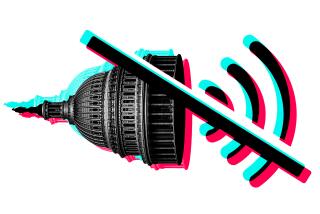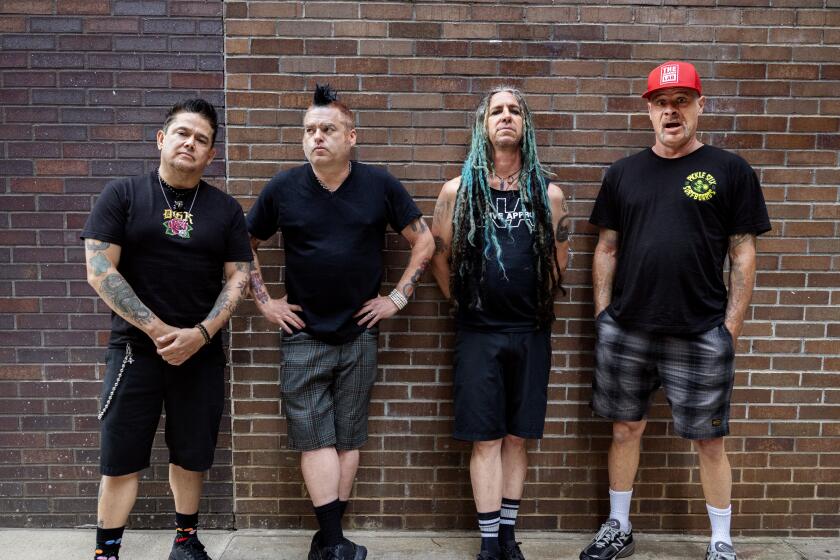Sales secondary in this business model
Mash-up artist Girl Talk’s new album, “Feed the Animals” comes with some impressive numbers: About 300 sampled songs on 14 tracks that play for a manic 55 minutes.
One number it doesn’t come with, however, is a price.
That’s because Girl Talk, as Gregg Gillis calls himself, is adopting the model pioneered by artists such as Radiohead that allows fans to name their own price for a digital download of his new album. Although Radiohead never disclosed how many downloads it sold, it didn’t appear to harm CD sales when the album was released several months later.
Gillis’ strategy will test whether an independent artist who has never benefited from the backing of a major record label can build an audience and generate income on the experimental pay-what-you-want model. At the same time, “Feed the Animals” must maintain a low-enough profile to ensure the samples -- brief excerpts from other artists’ music -- used without permission on the album go uncontested by their copyright holders.
“It’s a perfect model for the kinds of acts that appeal to a devoted group of fans who are older than teenagers on average, and who are computer literate,” said Aram Sinnreich, managing partner at Radar Research, a media consulting firm. “Anybody who’s a fan of remixes and mash-ups is going to be inclined in that direction.”
Whether they will be sufficiently inclined to pay for something they can also get free is an open question. “Feed the Animals” is the fourth album from Gillis, a Pittsburgh resident known for taking samples from the music of other artists and mixing them into a new song. A single track on “Feed the Animals” can include more than a dozen snippets of songs from such artists as Kanye West, Ace of Base, Cat Stevens and Salt-N-Pepa.
Several retailers -- including iTunes -- wouldn’t sell Gillis’ 2006 “Night Ripper” when it was released because he had not obtained permission to use the samples in the album.
This time, however, there is no middleman to block sales.
People who want to buy Gillis’ new album simply go to the Internet site and type in the price they are willing to pay for the download. If they don’t want to pay, they must check off one of eight reasons, including “I may donate later,” “I can’t afford to pay,” and “I don’t really like Girl Talk,” before downloading. Those who pay $10 (plus shipping) also will get a CD sent to them when it’s released in September.
But how much revenue “Feed the Animals” collects will not be the sole measure of the model’s success, said Philo T. Farnsworth, founder of Illegal Art (who borrowed his name from the inventor of the television). The music label’s roster includes Girl Talk. The pay-what-you-want model has an additional value -- some would argue it’s primary value -- in raising awareness about an artist’s work.
“Even if everyone who downloads it doesn’t pay, even if they get it all for free, it creates fan loyalty and exposes the artist to a lot of people who may not have been exposed to him otherwise,” Farnsworth said. Gillis, who earns most of his money touring, agreed.
“Priority No. 1 is getting the music out there,” he said.
Even though Gillis and Farnsworth won’t divulge sales, they say they are satisfied with the album’s performance. Farnsworth said most people who bought the download paid about $10, with a few offering $20 and one benefactor even paying $50.
But despite Girl Talk’s fan following, several thousand downloaders opted not to pay, which raises the question: If people expect so much free from the Internet, in the end will they be willing to pay for music if they don’t have to?
That prospect doesn’t worry Ian Rogers, former head of Yahoo Music and current chief executive of Topspin Media, which develops pay-what-you-want software for music artists. He thinks that because the model lets artists connect with fans, sales will result.
“Everybody can probably name three or four artists for whom they would go out of pocket in a larger-than-normal way, whether that’s pay-what-you-want, a subscription service for Pearl Jam shows or a $300 box set of Trent Reznor,” Rogers said, mentioning the Nine Inch Nails front man who has experimented with various pricing models.
More troubling for Farnsworth than those who downloaded without paying was the tapering interest among fans after a few days, suggesting that the pay-what-you-want model may be good at garnering publicity to create an event but can’t sustain itself.
“The big question on my mind is whether this will work in the long run,” Farnsworth said. “How many people will still want to pay for this in six months?”
Nonetheless, Farnsworth says he’s not deterred and wants to move his entire roster of 12 artists to a pay-what-you-want model beginning this month. He will include recordings that have previously been released on CD. “With the older material, we have nothing to lose,” he said. The first will be Steinski, a hip-hop and sampling pioneer who is one of Illegal Art’s biggest names.
That’s nice, but it all may be a bit overwhelming for fans, who may not want to be taxed with determining how much to pay for each album they purchase, said Sinnreich of Radar Research. Unlike iTunes, for example, where every track costs 99 cents, Sinnreich noted that people may not want to make the effort to assign a value for each purchase.
“Ultimately it’s just too much work for the consumer,” Sinnreich said. “This is an intelligent way to use the marketplace to create dialogue between artists and fans. But it’s not an indication of what the industry will look like in the future.”
--
More to Read
The biggest entertainment stories
Get our big stories about Hollywood, film, television, music, arts, culture and more right in your inbox as soon as they publish.
You may occasionally receive promotional content from the Los Angeles Times.










